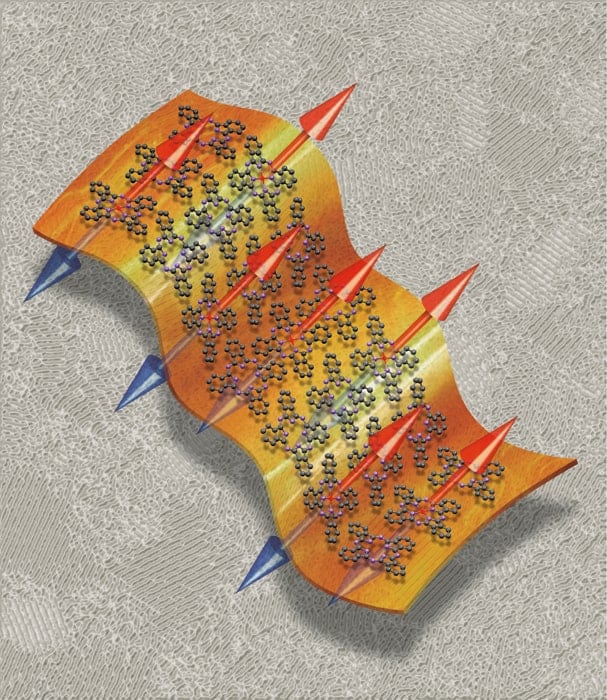
A common blue dye used in £5 Bank of England notes could hold the key to spintronic devices after physicists in the UK and Canada discovered that its electron spins have surprisingly long quantum decoherence times. Marc Warner and colleagues at University College London and the University of British Columbia have found that copper phthalocyanine (CuPc), which has been used as a dye since the 1930s, can have a decoherence time of as long as 3 μs. While this is still shorter than the times available using the spins associated with nitrogen vacancy (NV) impurities in diamond, the latter structures are difficult to work with.
Spintronics is all about exploiting the spin of an electron as well as its electrical charge, with, for example, spin-up corresponding to a binary “1” and spin-down to “0”. In principle, spintronic circuits could be made much smaller and more energy efficient than conventional electronics. The concept can also be extended to single electrons that could function as quantum bits of information – or qubits – which could form the basis of quantum computers. A big challenge, however, is to find materials in which the spin state lasts long enough to store and process information in practical devices.
In this latest study, Warner and colleagues used a molecular-deposition technique to create a film comprising about 1000 individual layers of CuPc and hydrogen phthalocyanine (H2Pc). They kept the ratio of CuPc to H2Pc molecules relatively low – between 0.1 and 10% in different samples – to ensure that the average distance between the copper atoms is large enough to prevent their spins from interacting with each other as this would shorten their relaxation times.
The team measured how long the spin states endure by using electron spin resonance (ESR), which involves placing the sample in a magnetic field and then using microwaves to cause transitions between spin states. The researchers were interested in two particular time parameters related to the spin states. One is the “population relaxation time” (T1), which indicates how long it takes for an ensemble of spins pointing in the same direction to reach the state where the spins are pointing in random directions. T1 is an important parameter for spintronics applications that do not involve quantum information. The other parameter is the “phase memory time” or decoherence time (T2), which says how long quantum information could be stored in the spin of copper atom.
When the team measured T1 in films, it found a rapid drop in the relaxation time as the amount of CuPc in the sample increased. In samples where the ratio of CuPc to H2Pc is about 0.1%, T1 was about 0.1 s. But when that ratio rose to about 10%, T1 fell to about 10 μs. These measurements were made at a chilly 5 K but when the temperature was increased to 80 K, the 0.1% T1 value also dropped to about 10 μs.
More potential for quantum computing
When it came to T2, the team found that spins in the 0.1% sample retained their coherence for about 3 μs at 5 K, dropping slightly to about 1 μs at 80 K. This performance is not quite as good as the spins associated with NV impurities in diamond, which some physicists believe could prove very useful for building quantum computers. However, CuPc is an easier material to work with than NV impurities and some other materials mooted for quantum computing.
“Our research shows that a common blue dye has more potential for quantum computing than many of the more exotic molecules that have been considered previously,” explains Warner, who is now at Harvard University in the US.
As well as having relatively long relaxation times, CuPc has several other properties that make it attractive for use in quantum computers. Unlike NV impurities in diamonds, CuPc interacts strongly with visible light: a property that could be used to create quantum devices that use both spins and light to process quantum information. The material is also easy to modify both physically and chemically, which means its properties can be changed to suit a range of applications.
The research is reported in Nature.



